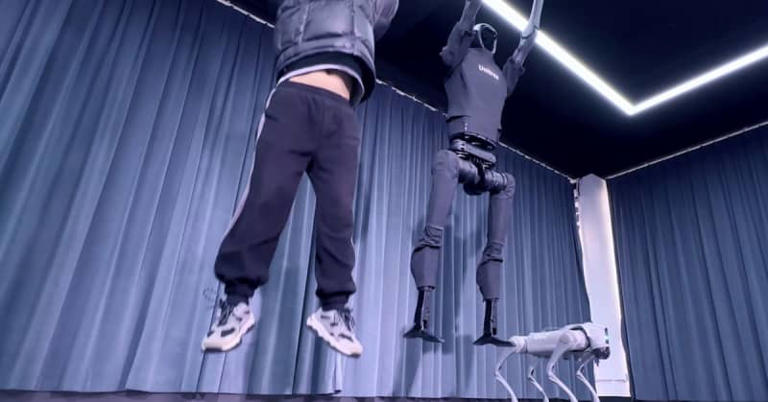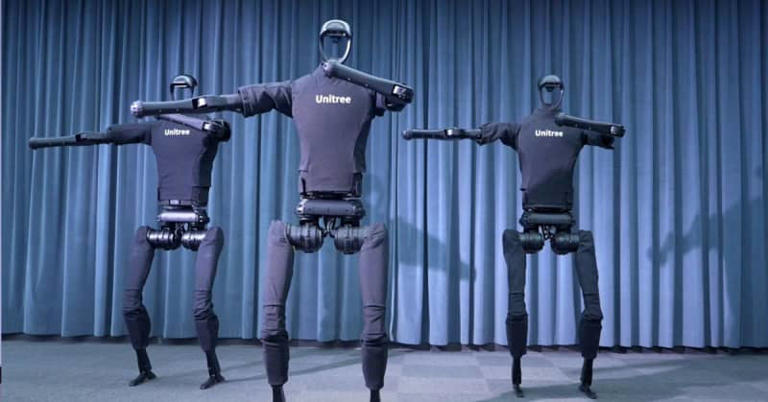It is powered into flight by a rocket engine. It can fly a distance equal to the width of China. It has a stealthy design and is capable of carrying missiles that can hit enemy targets far beyond its visual range.
But what really distinguishes the Air Force’s pilotless XQ-58A Valkyrie experimental aircraft is that it is run by artificial intelligence, putting it at the forefront of efforts by the U.S. military to harness the capacities of an emerging technology whose vast potential benefits are tempered by deep concerns about how much autonomy to grant to a lethal weapon.
Essentially a next-generation drone, the Valkyrie is a prototype for what the Air Force hopes can become a potent supplement to its fleet of traditional fighter jets, giving human pilots a swarm of highly capable robot wingmen to deploy in battle. Its mission is to marry artificial intelligence and its sensors to identify and evaluate enemy threats and then, after getting human sign-off, to move in for the kill.
On a recent day at Eglin Air Force Base on Florida’s Gulf Coast, Maj. Ross Elder, 34, a test pilot from West Virginia, was preparing for an exercise in which he would fly his F-15 fighter alongside the Valkyrie.
“It’s a very strange feeling,” Major Elder said, as other members of the Air Force team prepared to test the engine on the Valkyrie. “I’m flying off the wing of something that’s making its own decisions. And it’s not a human brain.”
The Valkyrie program provides a glimpse into how the U.S. weapons business, military culture, combat tactics and competition with rival nations are being reshaped in possibly far-reaching ways by rapid advances in technology.
The emergence of artificial intelligence is helping to spawn a new generation of Pentagon contractors who are seeking to undercut, or at least disrupt, the longstanding primacy of the handful of giant firms who supply the armed forces with planes, missiles, tanks and ships.
The possibility of building fleets of smart but relatively inexpensive weapons that could be deployed in large numbers is allowing Pentagon officials to think in new ways about taking on enemy forces.
It also is forcing them to confront questions about what role humans should play in conflicts waged with software that is written to kill, a question that is especially fraught for the United States given its record of errant strikes by conventional drones that inflict civilian casualt
And gaining and maintaining an edge in artificial intelligence is one element of an increasingly open race with China for technological superiority in national security.
ImageA straight on view of the Valkyrie in a hanger shows a pointed nose, wings, and tail fins.
The Valkyrie is a prototype for what the Air Force hopes can become a potent supplement to its fleet of traditional fighter jets, giving human pilots a swarm of highly capable robot wingmen to deploy in battle.Credit...Edmund D. Fountain for The New York Times
Military planners are worried that the current mix of Air Force planes and weapons systems — despite the trillions of dollars invested in them — can no longer be counted on to dominate if a full-scale conflict with China were to break out, particularly if it involved a Chinese invasion of Taiwan.
That is because China is lining its coasts, and artificial islands it has constructed in the South China Sea, with more than a thousand anti-ship and antiaircraft missiles that severely curtail the United States’ ability to respond to any possible invasion of Taiwan without massive losses in the air and at sea.
After decades of building fewer and fewer increasingly expensive combat aircraft — the F-35 fighter jet costs $80 million per unit — the Air Force now has the smallest and oldest fleet in its history.
That is where the new generation of A.I. drones, known as collaborative combat aircraft, will come in. The Air Force is planning to build 1,000 to 2,000 of them for as little as $3 million apiece, or a fraction of the cost of an advanced fighter, which is why some at the Air Force call the program “affordable mass.”
There will be a range of specialized types of these robot aircraft. Some will focus on surveillance or resupply missions, others will fly in attack swarms and still others will serve as a “loyal wingman” to a human pilot.
The drones, for example, could fly in front of piloted combat aircraft, doing early, high-risk surveillance. They could also play a major role in disabling enemy air defenses, taking risks to knock out land-based missile targets that would be considered too dangerous for a human-piloted plane.
The cheapest ones will be considered expendable, meaning they likely will only have one mission. The more sophisticated of these robot aircraft might cost as much as $25 million, according to an estimate by the House of Representatives, still far less than a piloted fighter jet.
“Is it a perfect answer? It is never a perfect answer when you look into the future,” said Maj. Gen. R. Scott Jobe, who until this summer was in charge of setting requirements for the air combat program, as the Air Force works to incorporate A.I. into its fighter jets and drones.
“But you can present potential adversaries with dilemmas — and one of those dilemmas is mass,” General Jobe said in an interview at the Pentagon, referring to the deployment of large numbers of drones against enemy forces. “You can bring mass to the battle space with potentially fewer people.”
The effort represents the beginning of a seismic shift in the way the Air Force buys some of its most important tools. After decades in which the Pentagon has focused on buying hardware built by traditional contractors like Lockheed Martin and Boeing, the emphasis is shifting to software that can enhance the capabilities of weapons systems, creating an opening for newer technology firms to grab pieces of the Pentagon’s vast procurement budget.
“Machines are actually drawing on the data and then creating their own outcomes,” said Brig. Gen. Dale White, the Pentagon official who has been in charge of the new acquisition program.
The Pentagon has spent several years building prototypes like the Valkyrie.Credit...Edmund D. Fountain for The New York Times
The Air Force realizes it must also confront deep concerns about military use of artificial intelligence, whether fear that the technology might turn against its human creators (like Skynet in the “Terminator” film series) or more immediate misgivings about allowing algorithms to guide the use of lethal force.
“You’re stepping over a moral line by outsourcing killing to machines — by allowing computer sensors rather than humans to take human life,” said Mary Wareham, the advocacy director of the arms division of Human Rights Watch, which is pushing for international limits on so-called lethally autonomous weapons.
A recently revised Pentagon policy on the use of artificial intelligence in weapons systems allows for the autonomous use of lethal force — but any particular plan to build or deploy such a weapon must first be reviewed and approved by a special military panel.
Asked if Air Force drones might eventually be able to conduct lethal strikes like this without explicit human sign-off on each attack, a Pentagon spokeswoman said in a statement to The New York Times that the question was too hypothetical to answer.
Any autonomous Air Force drone, the statement said, would have to be “designed to allow commanders and operators to exercise appropriate levels of human judgment over the use of force.”
Air Force officials said they fully understand that machines are not intelligent in the same way humans are. A.I. technology can also make mistakes — as has happened repeatedly in recent years with driverless cars — and machines have no built-in moral compass. The officials said they were considering those factors while building the system.
“It is an awesome responsibility,” said Col. Tucker Hamilton, the Air Force chief of A.I. Test and Operations, who also helps oversee the flight-test crews at Eglin Air Force Base, noting that “dystopian storytelling and pop culture has created a kind of frenzy” around artificial intelligence.
“We just need to get there methodically, deliberately, ethically — in baby steps,” he said.
The Pentagon Back Flip
Image
The walls of a wood-paneled corridor in the Pentagon are filled with portraits of past military leaders.

Portraits of a century’s worth of Air Force leaders and aircraft in the Pentagon highlight the iconic role of the pilot.Credit...Kent Nishimura for The New York Times
The long, wood-paneled corridor in the Pentagon where the Air Force top brass have their offices is lined with portraits of a century’s worth of leaders, mixed with images of the flying machines that have given the United States global dominance in the air since World War II.
A common theme emerges from the images: the iconic role of the pilot.
Humans will continue to play a central role in the new vision for the Air Force, top Pentagon officials said, but they will increasingly be teamed with software engineers and machine learning experts, who will be constantly refining algorithms governing the operation of the robot wingmen that will fly alongside them.
Almost every aspect of Air Force operations will have to be revised to embrace this shift. It’s a task that through this summer had been largely entrusted to Generals White and Jobe, whose partnership Air Force officers nicknamed the Dale and Frag Show (General Jobe’s call sign as a pilot is Frag).
The Pentagon, through its research divisions like DARPA and the Air Force Research Laboratory, has already spent several years building prototypes like the Valkyrie and the software that runs it. But the experiment is now graduating to a so-called program of record, meaning if Congress approves, substantial taxpayer dollars will be allocated to buying the vehicles: a total of $5.8 billion over the next five years, according to the Air Force plan.
Unlike F-35 fighter jets, which are delivered as a package by Lockheed Martin and its subcontractors, the Air Force is planning to split up the aircraft and the software as separate purchases.
Kratos, the builder of the Valkyrie, is already preparing to bid on any future contract, as are other major companies such as General Atomics, which for years has built attack drones used in Iraq and Afghanistan, and Boeing, which has its own experimental autonomous fighter jet prototype, the MQ-28 Ghost Bat.
A separate set of software-first companies — tech start-ups such as Shield AI and Anduril that are funded by hundreds of millions of dollars in venture capital — are vying for the right to sell the Pentagon the artificial intelligence algorithms that will handle mission decisions.
The list of hurdles that must be cleared is long.
The Pentagon has a miserable record on building advanced software and trying to start its own artificial intelligence program. Over the years, it has cycled through various acronym-laden program offices that are created and then shut down with little to show.
There is constant turnover among leaders at the Pentagon, complicating efforts to keep moving ahead on schedule. General Jobe has already been assigned to a new role and General White soon will be.
Image
A portrait of Maj. Gen. R. Scott Jobe wearing a green Air Force jumpsuit in front of a painting of many airplanes.

Maj. Gen. R. Scott Jobe was in charge of setting requirements for the air combat program until this summer.Credit...Kent Nishimura for The New York Times
Image
A portrait of Brig. Gen. Dale R. White wearing a camoflauge military uniform.

Brig. Gen. Dale White is the Pentagon official who has been in charge of the new acquisition program.Credit...Hailey Sadler for The New York Times
The Pentagon also is going to need to disrupt the iron-fisted control that the major defense contractors have on the flow of military spending. As the structure of the Valkyrie program suggests, the military wants to do more to harness the expertise of a new generation of software companies to deliver key parts of the package, introducing more competition, entrepreneurial speed and creativity into what has long been a risk-averse and slow-moving system.
The most important job, at least until recently, rested with General Jobe, who first made a name for himself in the Air Force two decades ago when he helped devise a bombing strategy to knock out deeply buried bunkers in Iraq that held critical military communication switches.
He was asked to make key decisions setting the framework for how the A.I.-powered robot airplanes will be built. During a Pentagon interview, and at other recent events, Generals Jobe and White both said one clear imperative is that humans will remain the ultimate decision makers — not the robot drones, known as C.C.A.s, the acronym for collaborative combat aircraft.
“I’m not going to have this robot go out and just start shooting at things,” General Jobe said during a briefing with Pentagon reporters late last year.
He added that a human would always be deciding when and how to have an A.I.-enabled aircraft engage with an enemy and that developers are building a firewall around certain A.I. functions to limit what the devices will be able to do on their own.
“Think of it as just an extension to your weapons bay if you’re in an F-22, F-35 or whatnot,” he said.
The Test Pilots
Image
A portrait of Maj. Ross Elder wearing a green jumpsuit with various military patches standing on a tarmac.

“It’s a very strange feeling,” Maj. Ross Elder said. “I’m flying off the wing of something that’s making its own decisions. And it’s not a human brain.”Credit...Edmund D. Fountain for The New York Times
Back in 1947, Chuck Yeager, then a young test pilot from Myra, W. Va., became the first human to fly faster than the speed of sound.
Seventy-six years later, another test pilot from West Virginia has become one of the first Air Force pilots to fly alongside an autonomous, A.I.-empowered combat drone.
Tall and lanky, with a slight Appalachian accent, Major Elder last month flew his F-15 Strike Eagle within 1,000 feet of the experimental XQ-58A Valkyrie — watching closely, like a parent running alongside a child learning how to ride a bike, as the drone flew on its own, reaching certain assigned speeds and altitudes.
The basic functional tests of the drone were just the lead-up to the real show, where the Valkyrie gets beyond using advanced autopilot tools and begins testing the war-fighting capabilities of its artificial intelligence. In a test slated for later this year, the combat drone will be asked to chase and then kill a simulated enemy target while out over the Gulf of Mexico, coming up with its own strategy for the mission.
During the current phase, the goal is to test the Valkyrie’s flight capacity and the A.I. software, so the aircraft is not carrying any weapons. The planned dogfight will be with a “constructed” enemy, although the A.I. agent onboard the Valkyrie will believe it is real.
Major Elder had no way to communicate directly with the autonomous drone at this early stage of development, so he had to watch very carefully as it set off on its mission.
“It wants to kill and survive,” Major Elder said of the training the drone has been given.
An unusual team of Air Force officers and civilians has been assembled at Eglin, which is one of the largest Air Force bases in the world. They include Capt. Rachel Price from Glendale, Az., who is wrapping up a Ph.D. at the Massachusetts Institute of Technology on computer deep learning, as well as Maj. Trent McMullen from Marietta, Ga., who has a master's degree in machine learning from Stanford University.
Image
An F-16 fighter jet sits on a runway under an awning.

Pilots at Eglin Air Force Base planned to fly their F-16 fighter jets in tandem with A.I.-directed jets.Credit...Edmund D. Fountain for The New York Times
One of the things Major Elder watches for is any discrepancies between simulations run by computer before the flight and the actions by the drone when it is actually in the air — a “sim to real” problem, they call it — or even more worrisome, any sign of “emergent behavior,” where the robot drone is acting in a potentially harmful way.
During test flights, Major Elder or the team manager in the Eglin Air Force Base control tower can power down the A.I. platform while keeping the basic autopilot on the Valkyrie running. So can Capt. Abraham Eaton of Gorham, Maine, who serves as a flight test engineer on the project and is charged with helping evaluate the drone’s performance.
“How do you grade an artificial intelligence agent?” he asked rhetorically. “Do you grade it on a human scale? Probably not, right?”
Real adversaries will likely try to fool the artificial intelligence, for example by creating a virtual camouflage for enemy planes or targets to make the robot believe it is seeing something else.
The initial version of the A.I. software is more “deterministic,” meaning it is largely following scripts that it has been trained with, based on computer simulations the Air Force has run millions of times as it builds the system. Eventually, the A.I. software will have to be able to perceive the world around it — and learn to understand these kinds of tricks and overcome them, skills that will require massive data collection to train the algorithms. The software will have to be heavily protected against hacking by an enemy.
The hardest part of this task, Major Elder and other pilots said, is the vital trust building that is such a central element of the bond between a pilot and wingman — their lives depend on each other, and how each of them react. It is a concern back at the Pentagon too.
“I need to know that those C.C.A.s are going to do what I expect them to do, because if they don’t, it could end badly for me,” General White said.
Image
A portrait of Captain Abraham Eaton wearing a green jumpsuit standing in front of a hangar on a tarmac.

Capt. Abraham Eaton, a flight test engineer on the project, is charged with helping evaluate how well the drone performs.Credit...Edmund D. Fountain for The New York Times
Image
Safety harnesses are hanging in individual shelves with lockers and helmets above them.

The human pilots require safety harnesses and helmets.Credit...Edmund D. Fountain for The New York Times
In early tests, the autonomous drones already have shown that they will act in unusual ways, with the Valkyrie in one case going into a series of rolls. At first, Major Elder thought something was off, but it turned out that the software had determined that its infrared sensors could get a clearer picture if it did continuous flips. The maneuver would have been like a stomach-turning roller coaster ride for a human pilot, but the team later concluded the drone had achieved a better outcome for the mission.
Air Force pilots have experience with learning to trust computer automation — like the collision avoidance systems that take over if a fighter jet is headed into the ground or set to collide with another aircraft — two of the leading causes of death among pilots.
The pilots were initially reluctant to go into the air with the system engaged, as it would allow computers to take control of the planes, several pilots said in interviews. As evidence grew that the system saved lives, it was broadly embraced. But learning to trust robot combat drones will be an even bigger hurdle, senior Air Force officials acknowledged.
Air Force officials used the word “trust” dozens of times in a series of interviews about the challenges they face in building acceptance among pilots. They have already started flying the prototype robot drones with test pilots nearby, so they can get this process started.
The Air Force has also begun a second test program called Project Venom that will put pilots in six F-16 fighter jets equipped with artificial intelligence software that will handle key mission decisions.
The goal, Pentagon officials said, is an Air Force that is more unpredictable and lethal, creating greater deterrence for any moves by China, and a less deadly fight, at least for the United States Air Force.
Officials estimate that it could take five to 10 years to develop a functioning A.I.-based system for air combat. Air Force commanders are pushing to accelerate the effort — but recognize that speed cannot be the only objective.
“We’re not going to be there right away, but we’re going to get there,” General Jobe said. “It’s advanced and getting better every day as you continue to train these algorithms.”
Image
A rear view of a Valkyrie autonomous aircraft looking out of a hangar toward a runway and the ocean.

Officials estimate that it could take five to 10 years to develop a functioning A.I.-based system for air combat.Credit...Edmund D. Fountain for The New York Times
https://www.nytimes.com/2023/08/27/us/p ... force.html


































































